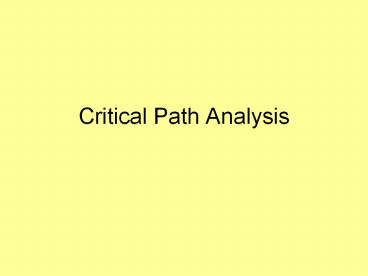Critical Path Analysis - PowerPoint PPT Presentation
Title:
Critical Path Analysis
Description:
Critical Path Analysis Why Is CPA Important? CPA is arguably the piece of maths used most often, outside of basic arithmetic. Important not only in commerce and ... – PowerPoint PPT presentation
Number of Views:311
Avg rating:3.0/5.0
Title: Critical Path Analysis
1
Critical Path Analysis
2
Why Is CPA Important?
- CPA is arguably the piece of maths used most
often, outside of basic arithmetic. - Important not only in commerce and industry, but
also in our own lives. - Can be used to ensure the efficient running of
any Project!
3
Project
- A Project can be defined as any activity with
- A defined purpose
- A clear start and finish
4
Other Considerations
- Other types of dependencies
- Planned delays e.g. plaster drying
- Start Start dependencies
- Delays on Critical Path, e.g.
- Goods not delivered
- Weather delays
5
Activities of a particular project are usually
set out in a precedent / dependent table. This
table shows the activities which cannot start
until a previous activity has been completed. An
example is as follows
ACTIVITY DEPENDS ON
A -
B -
C A, B
D B
E B
F C
G C, D
H E
6
The common method to establish the general shape
of an Activity Network, is to use an Activity on
Arc method.
Terminology Arc denoted by a straight line
which shows the activity. Node denoted by a
circle to signify the end of an activity. Each
node in numbered from 0 to n. Node 0 is called
the source node. The final node is called the
sink node. Dummy A dummy arc is required if a
particular activity requires two or more
activities to finish prior to the new activity
starting
7
Using our example dependent table.
3
C
F
1
A
G
4
6
0
B
D
H
2
E
5
8
An Alternative Approach......
9
WORKED EXAMPLE
ABC Manufacturing Ltd construct luxury sofas by
hand on an order by order basis. The sofa
consists of various tasks which must be completed
in order. The activities are as follows
A Build a Wooden Frame B Cut out material for
cushions C Stitch and fill cushions D Attach
springs to wooden frame E Cover Frame F
Complete Assembly G Inspect H Wrap
10
The information is supplied in a Dependency table
Activity Dependent on Time of Activity (hrs)
A - 6
B - 2
C B 3
D A 4
E D 2
F C, D 4
G F 2
H G 1
11
Your task is to create an activity network from
the information given, (hint you will require 1
dummy arcs).
12
E
D
4
1
A
7
H
0
0
B
6
G
2
3
5
C
F
13
Carrying out the algorithm
14
Step One Draw an Activity-On-Arc Network
15
Step Two The forward Pass
In the Left hand box, we write the EARLIEST TIME
that you can move onto the next task
6
16
6
10
17
2
10
16
14
This is 10 and not 5 because we have to have done
D as well as C before we can move onto F. We have
to pick the latest.
17
Step Three The backward Pass
In the Right Hand box we write the latest the
next activity needs to start in order to finish
on time. We go backwards. The first one is always
the same as the forward pass.
17
17
16 16
18
The box after D says 10 and not 15 because we
have to get F,G and H done. Activity E doesnt
have to start until 12, but we must write down
the lower number.
6
10
6
10
17
17
0
0
2
16
10
14
16
14
10
7
The box after B says 7 because in order to be
done by 10, C doesnt have to start until 7.
19
If the latest an activity must have finished by
take away the earliest it can start is the length
of the activity, then the activity is CRITICAL.
6
10
6
10
17
17
0
0
2
16
10
14
16
14
10
7
The CRITICAL PATH is the list of activities that
are CRITICAL. If an activity isnt critical, it
has FLOAT. E is not critical because 17- 10 gt 2.
E has a float of 5. E can start any time between
10 and 15.































